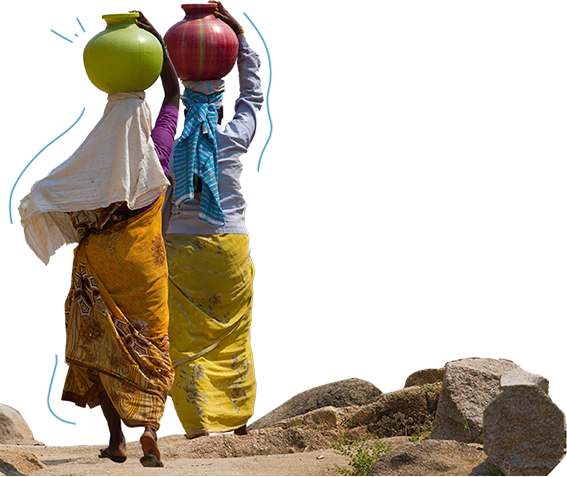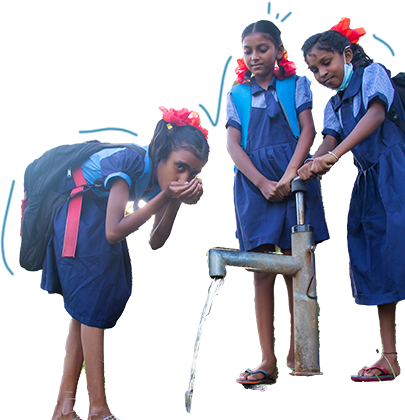


The Multi-pronged Drinking water problem
Solving for the drinking water problems
means addressing every one of these questions!

Voices
from the
Field
As on March 2024, there are 80,000+ habitations that are quality affected for drinking water and are suffering from hard contaminants (like fluorine,arsenic, iron – etc.) mixed in drinking water. These cannot be removed with simple filtration techniques like boiling or sand filtrations and need specialised water purification techniques. People who are unaware of their water contamination or those who cannot afford bear the risk of suffering from various water borne disease like diarrhoea, stomach infections, joint pains, fluorosis, arsenocosis and in very extreme cases can be reasons for disease like cancers.
Recalling the Bangalore water crisis 2024, it is not uncommon for us to see that in an otherwise water secure place, the situation in summers becomes really bad. One of the main reasons for many drinking water solutions to fail midway – is the the water source dries up making it unviable. Hence understanding if the water solution is poised to operate all year long is a very important criterion in choosing a water solution
The SDG 6, recommends that water is available whenever the family needs it. The general water supply timings in India is anything between 30 minutes to 12 hours and most of the time is available at peak times from 06.00 AM to 8.00 AM or 06.00 PM to 08.00 PM. This snatches away from women and adolescent girls in the family otherwise precious time from their day to day operations. As per 2019 time use survey – for households without access to on-premises water facilities across rural and urban India, more than 80 percent of women household members cater to water management-related unpaid domestic service activities. In comparison, only 20 percent of men in these households contribute their time to these necessities.
It is not uncommon for us to read that certain sections of the society are not allowed equal access to safe water. There is a beating of boy in one school or two women weren’t allowed to take drinking water from a temple in another state. It is quite unfortunate that certain social markers still restrict water access in rural India.
A simple and reliable water purifying machine costs anything between four thousand to eighteen thousand rupees. Not every family in the country is in a position to spend that amount to ensure safe drinking water and health to their family. Many private vendors who sell water cans and chilled water in camphors too charge something as high as Rs. 10/- to Rs. 20/- for. water can which not only makes the water costly but also without proof of quality. The Bisleri and Kinley drinking water 20 litre cans are as costly as Rs. 80/- or 120/- per can which almost makes it unaffordable for a large portion of the families living at the bottom of the pyramid.
With the Multi pronged drinking water problems as explained above, In many cases a private vendor or a group of people set up a water solution and the village becomes dependent on them to decide for the water needs. The role of panchayat and water committees is decreased or is becoming nominal in such cases. Keeping the best interests of all in the village/ habitation Naandi Community Water services, firmly believes that the solution needs to be owned and managed by the Panchayat.
Basis our observations in the community, the drinking water operations, maintenance and repair are dependent of the PHED, the RWS engineers or very few trained technicians who need to come from near by towns or urban clusters. These skilled technicians who are already occupied with other tasks either take a long time to address the drinking water repair aspect of charge exorbitantly to solve for the problem. In many cases the Panchayats could also be in a situation of over trusting these specialised skilled people and paying more than what is required. Not having the necessary know-how in these matters not only delays the repair of the water solution keeping all households prone to drinking bad water but also escalates expenses. The uneasiness that Panchayats face in this aspect reflects in procrastinating the repair, not following up with ease and lack of stitch in time leads to a bigger failure of the water solution.
Timely testing the quality of drinking water, cleaning the pipes and storage tanks, Operations, maintenance and repairs, Switching on and off of the solution are all cost and time intensive actions that needs to be duly done to ensure that safe and contaminants free water is delivered. Performing these tasks round the clock needs expertise, efficiency and a minimum amount of cost to complete them in a community beneficial way. Many times – the quality of the drinking water solution is impacted and affected because the panchayat, the community or the NGO does not have there resources for many years to come. The grants are project bound or time bound and once the resources are diminished the quality of the intervention also starts to suffer.


